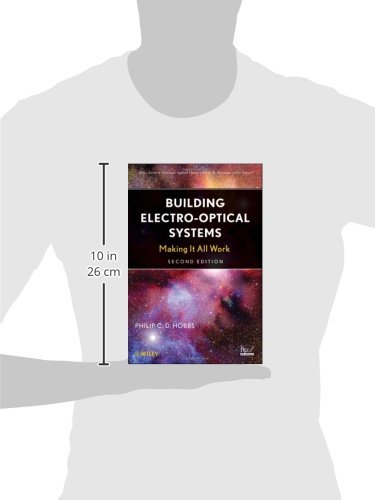معلومات عنا
دعم العملاء
احصل على التطبيق

قم بتوجيه الكاميرا لتنزيل التطبيق
حقوق الطبع والنشر © 2024 Desertcart Holdings Limited




Electro-Optical Systems 2e
J**.
The best practical reference for designing optical-electronic systems
If you work on precision measurement, have ever wished for better signal-to-noise ratios (SNR) in your measurements, or have ever designed a sub-optimal optical detection scheme, it is a grave mistake to not read this book. The book is a practical, grad-student-level guide to building optical and electrical systems of the type typically found in physics/engineering labs. Most of the book is a medium-depth guide by the author to the large variety of optics, sensors, and electronics typically employed for such work. The author tells the reader the important things necessary to know in order to work with or design systems around such elements. A good portion of this knowledge is the type normally passed down in an apprentice-style fashion, and while important, is either buried behind formulas or not mentioned in most other textbooks. If I had known about this book earlier, it would have saved me many hundreds of hours when I was a graduate student. This book is the first place I look when designing new systems with parts/devices/methods I am not intimately familiar with.There are many things I like about this book. Here are a few that come to mind: a) When explaining why a specific device or approach should be employed, an intuitive explanation is always given, rather than sole reliance on equations. b) The author can be counted on to warn readers about obvious pitfalls that are usually learned the hard way. For example, the last handful of bits in a 24 bit Sigma Delta ADC are typically useless, transimpedance amplifiers can push noise out to high frequencies, and metal film resistors are generally best to use over other types. c) The author has a lot, a lot of good tricks he's learned over the years: For example, a flashlight is an excellent shot-noise-limited light source. d) As the author points out, most people who design electronics are not necessarily experts in optics. The author however is an expert in both, and this expertise is apparent in his designs of integrated systems for laser noise cancelling, etc. e) The author gives lists of his favorite op-amps, BJTs, etc. f) The text is written in a relaxed, colloquial fashion and can at times be fairly humorous.I have a very few complaints about this book. My biggest complaint is that the current edition (sold here) does not have the useful "Rules of Thumb" (e.g. Johnson noise of a 60.4 Ohm resistor is 1 nV/Hz^(1/2) at 300 K, photocurrent shot noise is equal to Johnson noise when the terminating resistor drops 50 mV, etc.) printed on the inside cover, as did previous editions.Overall, this is the most useful book I've encountered as a scientist in my field and I consistently recommend it to my colleagues. Their feelings on this book are similar to mine.
M**R
Provides all the information that one needs to succeed as an experimentalist in graduate school and beyond
This book provides a grand overview of all the topics one needs to consider when designing optical systems. All components and details of the book have been clearly thought out in great detail and the style of the book is written so it feels like you are having a colloquial conversation in spite of the complex subject matter. This effect is compounded through Hobbs's detailed insertion of humor which makes key points stick out in your mind long after reading the text.Reading this book can save you countless hours in both debugging any experiment and in improving experiments to optimize performance/speed so that everything goes much faster.Just about any problem faced in our experiment has already been thought of in great detail by Hobbs and he makes it very clear and intuitive why certain design choices are correct and why other ones will lead you down dangerous paths.I highly recommend that this book be included in the personal collections of any experimentalist/engineer.
S**R
Good read!
Good read! A lot of useful insight
P**M
A fantastic compendium of practical tips and advice
This is a spectacular book. Practical optics and opto-electronics techniques have traditionally been handed down from experienced practitioners to apprentices in the lab, and there are precious few other resources from which one can learn many of the important tricks that make life so much easier when realizing opto-electronic systems. This book is a gold mine of valuable practical tips and techniques that would take half a career (or more) of mistakes for one to stumble upon independently.
ترست بايلوت
منذ أسبوع
منذ شهر